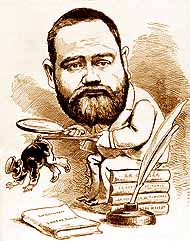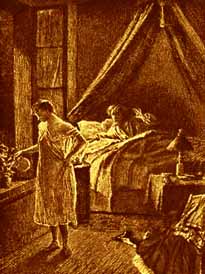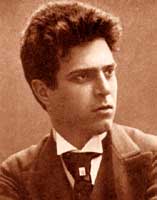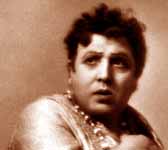Verismo
By Buoso Donati
"Verismo" as applied to opera is a problematic term. Originally used to describe a particular literary genre it came to be applied to operas whose libretti took their inspiration from that genre. Unfortunately, the term remained in vogue long after the composers of this "school" moved on to other subject matter, much of it decidedly not veristic. "Verismo" was coined in the 1870s to describe a group of writers, mostly from the fringes, geographically and often socially, of Italy. The majority were from the south with many like Giovanni Verga and Luigi Capuana hailing from Sicily.
Though it literally translates as "Realism", "Verismo" denotes the Italian wing of "Naturalism", which appeared in France somewhat earlier and whose most prominent practitioner was Emile Zola. Inspired by "Positivism", the naturalists believed that reality could be best represented and understood scientifically. The narrator was merely an impersonal, dispassionate, even clinical recounter of the facts of everyday life, facts which were presented with a "scientific rigor" as Verga himself once said. Objectivity was the aim in direct contrast to the subjectivity of romanticism. The naturalist's subjects were real and contemporary events, his style straightforward and anti-rhetorical privileging the language as spoken. A famous cartoon of Zola best embodies the perspective of Naturalism. It showed the author in a lab coat holding a magnifying glass over a wriggling worker suspended from tweezers. Zola's naturalism reflected the effects of industrialization on class and society.

The "Rougon-Macquart" cycle was intended as an encyclopedic account of contemporary France. encompassing all levels of society. "Verismo" in Italy, however, was much more amorphous due to the recent unification of the peninsula and the almost total lack of industrialization. Where Zola's naturalism was more metropolitan in focus, "Verismo" was more a narrative of the rural poor. Though Verga projected a Rougon-Macquart-like cycle, "I Vinti" ("The Conquered"), he only completed two parts: I Malavoglia and Mastro Dom Gesulado. The novels which were supposed to deal with the upper classes of society were never written, arguably because those classes were in the process of coming into being at the time. Cavalleria Rusticana was originally a short story which became a sensation in 1884 when it was turned into a popular play. So it was natural to apply the term "verismo" to those operas which, nearly 20 years after the appearance of Capuana's novel Giacinta (considered the first example of the naturalist school in Italy), took "veristic" sources for their libretti.

Illustration from an early edition of Verga's
Cavalleria Rusticana
Cavalleria Rusticana

Mascagni had gone straight to the master himself, Verga, in 1890; Leoncavallo took his inspiration for I Pagliacci two years later from one of his father's court cases (in fact Tonio's "Prologo"can be read as the credo of literary "verismo" set to music, even incorporating the Italian equivalent for the French naturalists' "une tranche de vie" : "uno squarcio di vita" - a "slice of life"); Giordano's Mala Vita of the same year depicted Naples in all its squalor (Hanslick in reviewing a performance summed up the general critical attitude toward "verismo" both in opera and literature: "In its merciless truthfulness to life, Mala Vita is both gripping and revolting at the same time, like most of these veristic works."). Even Puccini came by his "verismo" tag honestly when he set Murger's novel of bohemian life in Paris as La Bohème 1896.
The problem with "verismo" as applied to opera comes when the composers move on to different and varied subject matter - some of it as far from everyday life (save allegorically) as Dorothy's OZ - yet the tag remains. So if the subject matter is no longer veristic, what about these operas can be validly ascribed to" verismo"? What validity can the term have if its original meaning is obsolete? Could it be the music?
Illustration by Montader for an early edition
of Murger's Scenes de la Vie de Bohème
I would say, no. There is nothing dispassionate, impersonal, or clinical about the narrator of "verismo" operas: the post-Wagner orchestra in full cry. Applying the term "verismo" here is misleading, though that's not to say that it isn't done. Much of what comes to be thought of as "verismo" musically is not new or unique; it had been evolving long before 1890 and much of it due to Wagner's influence. Musically speaking, there is really nothing revolutionary in Cavalleria Rusticana. It was composed in the traditional "closed number" style, that is an instrumental introduction, followed by an aria or ensemble, finishing up with a postlude. The often emphatic, declamatory vocal lines anchored for the most part in the middle to upper middle registers and where the tessitura can suddenly jump do achieve something musically akin to speech - a primary aim of "verismo" stylistics in literature --but Mascagni was by no means the first to do this.
Where I would suggest literary "verismo" and operatic "versimo" continue to intersect, and have meaning regardless of subject matter or musical style, is in the realm of the vocal and performance style of the singers who came to make these works the mainstay of their repertory. Literary "verismo" became popular in this resolutely illiterate peninsula only through the theater. Not many could read or even afford to buy Verga's short story, but they could well afford and understand a play whether in a theater or given by a traveling troupe in the town square. Such was the success of these "verismo" theatricals that they came to be known simply as "scene populari" ( loosely, "plays for and about the people"). The predominant acting style in Italy at that time was one of broad and grand gestures. "Tearing a passion to tatters" was not a rare occurrence, particularly in the provinces and in outdoor venues. Much of what we consider artificial and over the top in "verismo" operas was considered good acting on the Italian stage.
Singing is not the most realistic form of expression. The "verismo" sobs and gulps along with the emphasis on the text and the use of word coloring and the dreaded chest voice for expressivity were a way of making more real something which on the face of it isn't- to make opera mirror the performance practice of the spoken theater in Italy. In fact, lines which composers set to music came to be spoken - something literally unheard of before: "Davanti a lui tremava tutta Roma" ; "A te la mala Pasqua" being two examples which come readily to mind. A critic whose name escapes me once described the verismo vocal style as "al limite dell'urlo": "approaching the boundaries of shouting". I would say it could often cross that boundary in the name of realistic dramatic effect. A high note approaching a scream would be out of place in bel canto but right at home in "verismo". In the past, high notes capped an aria as a gesture of bravura and finality. In the verismo style, high notes occur where dramatically required. Consider the fact that most verismo arias conclude on a note in the center of the voice and often executed with a "messa di voce" (a tapering off dynamically) : " Che gelida manina" ,"Vesti la giubba", "Io sono l'umile ancella", "Vissi d'arte", "E lucevan le stelle", and the "Lamento di Federico" from L'Arlesiana are good examples.

Pietro Mascagni
To our ears, none of this vocalism may sound appropriate, but it obviously did to those who experienced these operas as the cutting edge of the modern. This style was considered natural and dramatic at the time. Singers were expected to act not just stand and deliver. Anecdotal evidence suggests that the combination of this type of vocalism with a convincing stage presence was persuasive and made for great theater. Aureliano Pertile is often cited as an example of the excesses of "verismo" vocalism. However, it is well to remember how much Toscanini prized him as an actor as well as a singer (not to mention many other "verismo" singers when he ran La Scala). His is a case where I think eyewitness (and earwitness) testimony trumps shellac. Yes, there are excesses on Pertile's recordings where he is left to his own devices, but from all accounts, live in theater - and particularly during his heyday under Toscanini at La Scala - he was a compelling and convincing actor and a disciplined singer. Accounts of his performance as the title character in Nerone, for example, all mention his striking portrayal of the emperor as well as his successfully coping with the tessitura of this fiendishly difficult role. From late in his career comes the anecdote - from Pavarotti, I believe - describing a visit to the old tenor's dressing room before a performance of Manon Lescaut . His visitors were appalled at the appearance of this portly short man whose hair came out of a box and teeth out of a jar and whose dresser was busy cinching him into a girdle. Once the performance began they were struck dumb by the ardent and utterly convincing Des Grieux who took the stage and sang.
FURTHER READING
Uno Squarcio di Vita: Vocal Aspects of Italian Verismo by Konrad Claude Dryden

Aureliano Pertile as Nerone
This page was last updated on: May 29, 2006